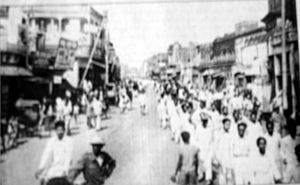Bengali language movement facts for kids
The Bengali Language Movement (Bengali: ভাষা আন্দোলন, romanized: Bhasha Andolôn) was a big political effort in what was then called East Bengal. This area later became East Pakistan in 1952. The people there wanted the Bengali language to be an official language of Pakistan. This would mean it could be used in government, schools, media, money, and stamps. They also wanted to keep using the Bengali script.
When Pakistan was created in 1947 after the British left, it had many different groups of people. East Bengal, which was far away from West Pakistan, had mostly Bengali-speaking people. In 1948, the government of Pakistan decided that Urdu would be the only national language. This made many Bengali speakers very upset. Some even suggested writing Bengali in Arabic script or Roman script, or making Arabic the state language.
Because of the growing anger, the government banned public meetings. But students from the University of Dhaka and other activists ignored the ban. They organized a protest on 21 February 1952. The movement became very intense when police shot and killed student protesters that day. These deaths caused huge public anger. After years of struggle, the government finally agreed. Bengali became an official language in 1956.
The Language Movement helped Bengalis in East Bengal feel proud of their identity. It led to other movements, like the 6 Point Movement and eventually the Bangladesh Liberation War. In Bangladesh, 21 February is now a national holiday called Language Movement Day. The Shaheed Minar monument was built in Dhaka to remember those who died. In 1999, UNESCO declared 21 February as International Mother Language Day. This day honors the Language Movement and the right of people worldwide to use their own languages.
Contents
Why the Language Movement Started
Before 1947, Pakistan and Bangladesh were part of British India. From the mid-1800s, leaders promoted the Urdu language for Muslims in India. Urdu uses a Perso-Arabic script and was seen as important for Islamic culture.
However, most Muslims in Bengal (eastern India) spoke Bengali. Bengali is a very old language with a rich history and literature. Bengalis, no matter their religion, used Bengali. Even before India was divided, people from Bengal disagreed with making Urdu the main language for all Muslims.
Early Protests for Bengali Language Rights
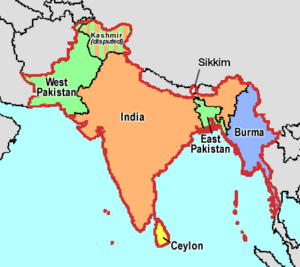
After India was divided in 1947, East Bengal became part of Pakistan. Bengali speakers made up a large part of Pakistan's population. But the government and military were mostly controlled by people from West Pakistan.
In November 1947, a meeting in Karachi suggested that only Urdu and English should be state languages. Students in Dhaka immediately protested. They demanded that Bengali also be an official language. The Pakistan Public Service Commission even removed Bengali from its list of approved subjects. It was also removed from money and stamps.
The education minister, Fazlur Rahman, wanted Urdu to be the only state language. This made people very angry. On 8 December 1947, many Bengali students met at Dhaka University. They formally demanded that Bengali become an official language. Students organized marches and rallies in Dhaka to support their cause.
Important Bengali scholars explained why Urdu should not be the only state language. Writer Abul Mansur Ahmed said that if Urdu became the state language, educated people in East Bengal would struggle to get government jobs. The first committee to support Bengali as a state language was formed in December 1947.
Proposals for Different Scripts
Some people suggested writing Bengali in the Arabic script to link it more with Islamic culture. Others, like Muhammad Qudrat-i-Khuda, even proposed using the Roman script for Bengali. However, many scholars, like Muhammad Shahidullah, opposed these ideas. They wanted Bengali to remain unchanged as a state language.
Protests in 1948
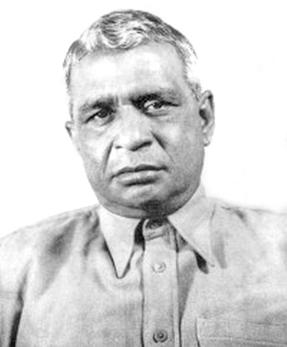
Students in Dhaka held a big strike on 11 March 1948. They protested that Bengali was not used officially on coins, stamps, or in navy recruitment tests. They demanded that Bengali be declared an official language. Many political leaders and students, including Sheikh Mujibur Rahman, were arrested during these protests.
Later that day, students marched towards the chief minister's house. Police attacked the marchers, hurting several students and leaders. Strikes continued for four more days. The chief minister, Khawaja Nazimuddin, signed an agreement with student leaders. But he did not agree to make Bengali a state language.
Jinnah's Visit to Dhaka
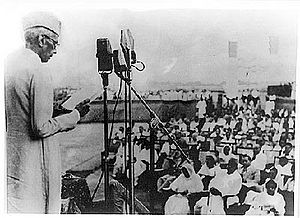
On 19 March 1948, Pakistan's leader, Muhammad Ali Jinnah, came to Dhaka. On 21 March, he said that the language issue was an attempt to divide Pakistani Muslims. Jinnah declared that "Urdu, and only Urdu" would be the state language. He called those who disagreed "Enemies of Pakistan." Jinnah gave a similar speech at Dhaka University. At both events, many people in the audience interrupted him. He later ignored the agreement signed by Khawaja Nazimuddin. Before leaving Dhaka, Jinnah repeated his "Urdu-only" policy on the radio.
Events of 1952
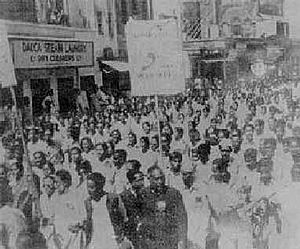
The debate over Urdu and Bengali started again when Jinnah's successor, Khawaja Nazimuddin, strongly supported the "Urdu-only" policy on 27 January 1952. On 31 January, a new committee called the Shorbodolio Kendrio Rashtrobhasha Kormi Porishod (All-Party Central Language Action Committee) was formed. This committee called for a big protest on 21 February, including strikes and rallies. To stop the protest, the government banned any gatherings in Dhaka.
Despite the ban, students gathered at Dhaka University on 4 February. They protested the idea of writing Bengali in Arabic script and demanded Bengali as a state language. They then held a large demonstration.
21 February: The Climax
On the morning of 21 February, students gathered at Dhaka University, ignoring the ban. Police surrounded the campus. Students tried to break the police line. Police fired tear gas to warn them. Some students ran into Dhaka Medical College, while others rallied near the police line.
The university leader asked police to stop firing and told students to leave. But police arrested several students for breaking the ban. Angered by the arrests, students gathered near the East Bengal Legislative Assembly. They blocked the way for lawmakers, asking them to speak up in the assembly. When some students tried to enter the building, police opened fire. They killed several students, including Abdus Salam, Rafiq Uddin Ahmed, Shafiur Rahman, Abul Barkat, and Abdul Jabbar. The government reported that 29 people died that day.
As news of the killings spread, the city became chaotic. Shops, offices, and public transport closed down. A general strike began. In the assembly, some lawmakers asked the chief minister, Nurul Amin, to visit the wounded students and stop the assembly to show respect. But Nurul Amin refused.
22 February: More Protests
Anger spread across the province. Large protests ignored the ban and condemned the police actions. More than 30,000 people gathered at Curzon Hall in Dhaka. During these protests, police actions led to four more deaths. Office workers, bank employees, and radio staff joined the protests. Protesters burned the offices of two pro-government news agencies. Police also fired on a large mourning rally, killing several people, including a nine-year-old boy named Ohiullah.
Continued Unrest and Memorials
On the night of 23 February, Dhaka Medical College students built a Shaheed Smritistombho (Monument of Martyrs). It was finished by dawn on 24 February. The father of a slain activist, Sofiur Rahman, opened the monument. However, police destroyed it on 26 February. On 25 February, workers in Narayanganj held a general strike. A protest on 29 February faced harsh police beatings.
The government tried to hide the news and exact number of deaths. Most pro-government media blamed Hindus and communists for the unrest. Families of the killed students tried to charge the police with murder, but the charges were dismissed.
What Happened Next
The Language Movement created a strong sense of Bengali identity in East Bengal. But it also increased tension between East and West Pakistan. In West Pakistan, some saw the movement as an attack on Pakistani national interests. They believed rejecting Urdu went against Islamic culture and the idea of Pakistan. Some powerful politicians thought Urdu was part of Indian Islamic culture, while Bengali was "Hinduized."
First Anniversary and Political Changes
The Shorbodolio Kendrio Rashtrobhasha Kormi Porishod, with support from the Awami Muslim League, decided to celebrate 21 February as Shohid Dibosh (Martyrs' Day). On the first anniversary, people in East Bengal wore black badges. Most offices, banks, and schools closed. Over 100,000 people gathered at a public meeting in Dhaka.
In 1954, elections were held in East Bengal. The ruling Muslim League lost badly to the United Front coalition. The United Front wanted more power for the province. The new government ordered the creation of the Bangla Academy to promote Bengali language and culture.
Bengali Becomes a State Language
Because the Muslim League lost the elections, the central government became more open to recognizing Bengali as a state language. On 7 May 1954, the assembly agreed to make Bengali an official language. Bengali became an official language of Pakistan, along with Urdu, when Pakistan's first constitution was passed on 29 February 1956. This meant people could speak Bengali in Parliament and the Legislative Assembly. The constitution also allowed for higher education in Bengali.
However, later military governments tried to make Urdu the only national language again. But in 1959, the military government officially supported the 1956 constitution's policy of two state languages.
Bangladesh's Independence
Even though the language issue was settled by 1956, the military government of Ayub Khan favored West Pakistan. East Pakistan had more people but received less money and fewer jobs in government and the military. These differences led to growing tensions. The Bengali nationalist Awami League started the Six point movement for more provincial power. One demand was to call East Pakistan Bangladesh (Land of Bengal). This eventually led to the Bangladesh Liberation War and the creation of independent Bangladesh in 1971.
Cultural Impact and Celebration
In Bangladesh
The Language Movement had a huge impact on Bengali culture. It inspired the growth and celebration of the Bengali language, literature, and culture. 21 February, known as Language Movement Day or Shohid Dibosh (Martyrs' Day), is a very important national holiday in Bangladesh.
Every year, a month-long event called the Ekushey Book Fair is held to remember the movement. The Ekushey Padak, one of Bangladesh's highest awards, is given each year to honor the sacrifices made during the movement. Songs like Abdul Gaffar Choudhury's Ekusher Gaan and plays, art, and poetry helped stir people's emotions during the movement. Many poems, songs, novels, plays, films, and paintings have been created about the movement.
A new Shaheed Minar (Monument of Martyrs) was built in 1954 after the first one was destroyed. Work on a larger monument began in 1957. It was designed by architect Hamidur Rahman. His design showed a half-circular column symbolizing a mother with her martyred sons. Even though martial law stopped the work in 1958, the monument was finished and opened on 21 February 1963. Pakistani forces destroyed it during the 1971 war, but the Bangladeshi government rebuilt it in 1973.
Worldwide: International Mother Language Day
Bangladesh officially asked UNESCO to declare 21 February as International Mother Language Day. This idea was supported by everyone at a UNESCO meeting on 17 November 1999.
Images for kids
-
Muhammad Qudrat-i-Khuda proposed the romanisation of Bengali in the early stage of language movement.
-
East Bengal Language Committee headed by Muhammad Akram Khan recommended writing Bengali through Arabic characters.
See also
 In Spanish: Movimiento por la Lengua Bengalí para niños
In Spanish: Movimiento por la Lengua Bengalí para niños
- Bengali language activists
- Bengali Language Movement (Barak Valley)
- Bengali Language Movement (Manbhum)


